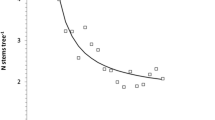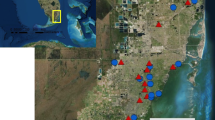Abstract
Trophic rewilding provides a nature-based solution for biological conservation; however, empirical studies demonstrating rewilding effects are limited. Megaherbivores moderate the type and quality of habitat available to other fauna. However, these effects may take time to develop. Further, fauna responses to megaherbivore rewilding will depend on a suite of life-history traits and strategies that allow persistence within megaherbivore modified landscapes. We conducted a space-for-time field survey in South African savanna to determine if habitat modifications mediated by a reintroduced megaherbivore, the African savanna elephant (Loxodonta africana), impacts the abundance of the diurnal arboreal cape dwarf gecko (Lygodactylus capensis) and two generalist diurnal skinks [the variable skink (Trachylepis varia) and striped skink (Trachylepis striata), collectively] across a 47-year period. The relative abundance of lizards and six habitat attributes utilized by lizards were assessed at 30 sites stratified across three biophysically and climatically similar nature reserves with different elephant reintroduction times (no elephants, 2003, 1972). The arboreal gecko was less common at the reserve with an older reintroduction time than the other reserves and was most commonly observed on, and positively correlated with, the density of the corkwood tree (Commiphora mollis). The generalist skinks were common across all reserves and were observed in a variety of habitats. Our results suggest that elephant rewilding differently impacts lizard species with different life-history strategies and that these effects take prolonged periods to develop. Given such knowledge, a long-term understanding of post-rewilding interactions will be a key point when designing and assessing the success of rewilding initiatives.




Similar content being viewed by others
Data availability
Data will be made available upon request.
Code availability
Code will be made available upon request.
References
Alexander G, Marais J (2013) A guide to the reptiles of Southern Africa. Penguin Random House South Africa, Cape Town
Archer SR, Andersen EM, Predick KI, Schwinning S, Steidl RJ, Woods SR (2017) Woody plant encroachment: causes and consequences. In: Briske DD (ed) Rangeland systems: processes, management and challenges. Springer, Berlin, pp 25–84
Bakker ES, Svenning JC (2018) Trophic rewilding: impact on ecosystems under global change. Philos Trans R Soc B 373:20170432
Barbosa AM, Brown J, Jiménez-Valverde A, Real R (2016) New measures for assessing model equilibrium and prediction mismatch in species distribution models. Divers Distrib 19:1333–1338
Bartoń K (2020) MuMIn: multi-model inference. R package version 1.43.17
Borquin O (2004) Reptiles (Reptilia) in KwaZulu-Natal: 1-diversity and distribution. Durban Mus Novit 29:57–103
Case MF, Wigley-Coetsee C, Nzima N, Scogings PF, Staver AC (2019) Severe drought limits trees in a semi-arid savanna. Ecology 100:e02842
Chase MJ et al (2016) Continent-wide survey reveals massive decline in African savannah elephants. Peer J 4:e2354
Davies AB, Gaylard A, Asner GP (2018) Megafaunal effects on vegetation structure throughout a densely wooded African landscape. Ecol Appl 28:398–408
De Beer Y, Kilian W, Versfeld W, Van Aarde RJ (2006) Elephants and low rainfall alter woody vegetation in Etosha National Park, Namibia. J Arid Environ 64:412–421
Duncan C, Thompson JR, Pettorelli N (2015) The quest for a mechanistic understanding of biodiversity–ecosystem services relationships. Proc R Soc B 282:20151348
Enquist BJ, Abraham AJ, Harfoot MB, Malhi Y, Doughty CE (2020) The megabiota are disproportionately important for biosphere functioning. Nat Commun 11:1–11
Estes JA et al (2011) Trophic downgrading of planet Earth. Science 333:301–306
Faurby S, Svenning JC (2015) Historic and prehistoric human-driven extinctions have reshaped global mammal diversity patterns. Divers Distrib 21:1155–1166
Ferreira SM, le Roex N, Greaver C (2019) Species-specific drought impacts on black and white rhinoceroses. PLoS ONE 14:e0209678
Grueber C, Nakagawa S, Laws R, Jamieson I (2011) Multimodel inference in ecology and evolution: challenges and solutions. J Evol Biol 24:699–711
Guldemond RA, Purdon A, Van Aarde RJ (2017) A systematic review of elephant impact across Africa. PLoS ONE 12:e0178935
Guyton JA et al (2020) Trophic rewilding revives biotic resistance to shrub invasion. Nat Ecol Evol 4:712–724
Hempson GP, Archibald S, Bond WJ (2017) The consequences of replacing wildlife with livestock in Africa. Sci Rep 7:1–10
Heyer R, Donnelly MA, Foster M, Mcdiarmid R (2014) Measuring and monitoring biological diversity: standard methods for amphibians. Smithsonian Institution, Washington
Hothorn T, Bretz F, Westfall P, Heiberger RM, Schuetzenmeister A, Scheibe S (2020) Multcomp: simultaneous inference in general parametric models R package version 1413
Malhi Y, Doughty CE, Galetti M, Smith FA, Svenning JC, Terborgh JW (2016) Megafauna and ecosystem function from the pleistocene to the anthropocene. Proc Roy Soc B 113:838–846
Meik JM, Jeo RM, Mendelson Iii JR, Jenks KE (2002) Effects of bush encroachment on an assemblage of diurnal lizard species in central Namibia. Biol Conserv 106:29–36
Midgley JJ, Coetzee BW, Tye D, Kruger LM (2020) Mass sterilization of a common palm species by elephants in Kruger National Park. S Afr Sci Rep 10:1–5
Miller DL, Rexstad E, Thomas L, Marshall L, Laake JL (2016) Distance sampling in R. J Stat Softw 063891
Mucina L, Rutherford MC, Powrie LW (2018) The Vegetation map of South Africa, Lesotho and Swaziland. South African National Biodiversity Institute. http://bgis.sanbi.org/SpatialDataset/Detail/18
Nasseri NA, McBrayer LD, Schulte BA (2011) The impact of tree modification by African elephant (Loxodonta africana) on herpetofaunal species richness in northern Tanzania. Afr J Ecol 49:133–140
Nyhus PJ (2016) Human–wildlife conflict and coexistence. Annu Rev Environ Resour 41:143–171
O’Connor TG (2017) Demography of woody species in a semi-arid African savanna reserve following the re-introduction of elephants. Acta Oecol 78:61–70
Owen-Smith RN (1988) Megaherbivores: the influence of very large body size on ecology. Cambridge University Press, Cambridge
Peel M (2014) Ecological monitoring: association of private nature reserves (Timbavati, Umbabat, Klaserie and Balule). Animal Production Institute: Livestock Business Division, South African Agricultural Research Council, Nelspruit
Pianka ER, Huey RB (1978) Comparative ecology, resource utilization and niche segregation among gekkonid lizards in the southern Kalahari. Copeia. https://doi.org/10.2307/1443698
Platts PJ, Omeny PA, Marchant R (2015) AFRICLIM: high-resolution climate projections for ecological applications in Africa. Afr J Ecol 53:103–108
Pringle RM (2008) Elephants as agents of habitat creation for small vertebrates at the patch scale. Ecology 89:26–33
R Core Team (2019) R: a language and environment for statistical computing. R foundation for statistical computing. Vienna, Austria. https://www.R-project.org/
Ripple WJ et al (2014) Status and ecological effects of the world’s largest carnivores. Science. https://doi.org/10.1126/science.1241484
Ripple WJ et al (2015) Collapse of the world’s largest herbivores. Sci Adv 1:e1400103
Robson AS, van Aarde RJ (2018) Changes in elephant conservation management promote density-dependent habitat selection in the Kruger National Park. Anim Conserv 21:302–312
Schmidt E, Lotter M, McCleland W (2002) Trees and shrubs of Mpumalanga and Kruger National Park. Jacana Media, Johannesburg
Schweiger AH, Boulangeat I, Conradi T, Davis M, Svenning JC (2019) The importance of ecological memory for trophic rewilding as an ecosystem restoration approach. Biol Rev 94:1–15
Sianga K, van Telgen M, Vrooman J, Fynn RW, van Langevelde F (2017) Spatial refuges buffer landscapes against homogenisation and degradation by large herbivore populations and facilitate vegetation heterogeneity. Koedoe 59:1–13
Simbotwe M (1983) Comparative ecology of diurnal geckos (Lygodactylus) in Kafue flats, Zambia. Afr J Ecol 21:143–153
Sirami C, Seymour C, Midgley G, Barnard P (2009) The impact of shrub encroachment on savanna bird diversity from local to regional scale. Divers Distrib 15:948–957
Stanton RA, Boone WW IV, Soto-Shoender J, Fletcher RJ Jr, Blaum N, McCleery RA (2018) Shrub encroachment and vertebrate diversity: a global meta-analysis. Glob Ecol Biogeogr 27:368–379
Stanton RA, Fletcher RJJ, Sibiya M, Monadjem A, McCleery RA (2020) The effects of shrub encroachment on bird occupancy vary with land use in an African savanna. Anim Conserv Early View. https://doi.org/10.1111/acv.12620
Stevens N, Erasmus B, Archibald S, Bond W (2016) Woody encroachment over 70 years in South African savannahs: overgrazing, global change or extinction aftershock? Philos Trans R Soc B 371:20150437
Svenning J-C et al (2016) Science for a wilder anthropocene: synthesis and future directions for trophic rewilding research. PNAS 113:898–906
Svenning JC, Munk M, Schweiger A (2019) Trophic rewilding: ecological restoration of top-down trophic interactions to promote self-regulating biodiverse ecosystems. In: Pettorelli N, Durant SM, Du Toit JT (eds) Rewilding. Cambridge University Press, Cambridge
Thomas L et al (2010) Distance software: design and analysis of distance sampling surveys for estimating population size. J Appl Ecol 47:5–14
Thornley R, Spencer M, Zitzer HR, Parr CL (2020) Woody vegetation damage by the African elephant during severe drought at Pongola Game Reserve, South Africa. Afr J Ecol Early View. https://doi.org/10.1111/aje.12736
Van Meerbeek K, Muys B, Schowanek SD, Svenning JC (2019) Reconciling conflicting paradigms of biodiversity conservation: human intervention and rewilding. Bioscience 69:997–1007
Venter Z, Cramer M, Hawkins H-J (2018) Drivers of woody plant encroachment over Africa. Nat Commun 9:1–7
Wato YA, Heitkönig IM, van Wieren SE, Wahungu G, Prins HH, van Langevelde F (2016) Prolonged drought results in starvation of African elephant (Loxodonta africana). Biol Conserv 203:89–96
Funding
The research was funded as part of a Carlsberg Foundation Semper Ardens grant (MegaPast2Future) awarded to Jens-Christian Svenning (Grant CF16-0005). JCS also considers this work a contribution to his VILLUM Investigator project “Biodiversity Dynamics in a Changing World” funded by VILLUM FONDEN (Grant 16549). Michelle Greve is supported by the South African National Research Foundation (Grant 116333).
Author information
Authors and Affiliations
Contributions
CEG and J-CS conceived the research idea; CEG, PA and RL conducted the fieldwork; CEG conducted the data analysis; all authors contributed to writing and editing the manuscript.
Corresponding author
Ethics declarations
Conflict of interest
The authors have no conflicts or competing interests.
Ethical approval
Scientific research approvals were obtained from the Mpumalanga Tourism and Parks Agency (No: 5651) and the Limpopo Department of Economic Development, Environment and Tourism (No: ZA/LP/96069).
Consent to participate
Reserve warden Collin Rowles gave consent to work on Klaserie Private Nature Reserve. Reserve wardens Craig Spencer and Ian Nowak gave consent to work on the other reserves.
Additional information
Communicated by Dirk Sven Schmeller.
Publisher's Note
Springer Nature remains neutral with regard to jurisdictional claims in published maps and institutional affiliations.
Supplementary Information
Below is the link to the electronic supplementary material.
Rights and permissions
About this article
Cite this article
Gordon, C.E., Lerm, R.E., Allin, P. et al. Elephant rewilding indirectly affects the abundance of an arboreal but not generalist savanna lizard. Biodivers Conserv 30, 1277–1291 (2021). https://doi.org/10.1007/s10531-021-02141-7
Received:
Revised:
Accepted:
Published:
Issue Date:
DOI: https://doi.org/10.1007/s10531-021-02141-7




